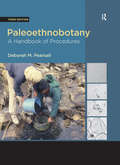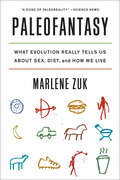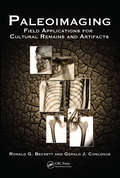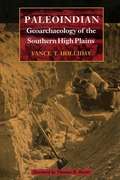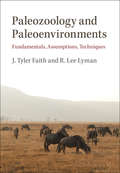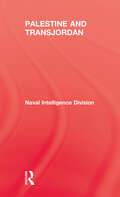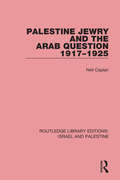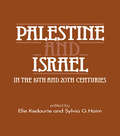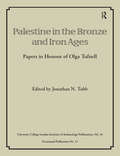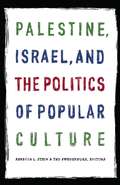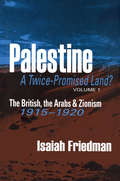- Table View
- List View
Paleoethnobotany: A Handbook of Procedures (The\missouri Archaeologist Ser. #Vol. 47)
by Deborah M PearsallThis new edition of the definitive work on doing paleoethnobotany brings the book up to date by incorporating new methods and examples of research, while preserving the overall organization and approach of the book to facilitate its use as a textbook. In addition to updates on the comprehensive discussions of macroremains, pollen, and phytoliths, this edition includes a chapter on starch analysis, the newest tool in the paleoethnobotanist's research kit. Other highlights include updated case studies; expanded discussions of deposition and preservation of archaeobotanical remains; updated historical overviews; new and updated techniques and approaches, including insights from experimental and ethnoarchaeological studies; and a current listing of electronic resources. Extensively illustrated, this will be the standard work on paleoethnobotany for a generation.
Paleofantasy: What Evolution Really Tells Us About Sex, Diet, And How We Live
by Marlene Zuk“With…evidence from recent genetic and anthropological research, [Zuk] offers a dose of paleoreality.” —Erin Wayman, Science News We evolved to eat berries rather than bagels, to live in mud huts rather than condos, to sprint barefoot rather than play football—or did we? Are our bodies and brains truly at odds with modern life? Although it may seem as though we have barely had time to shed our hunter-gatherer legacy, biologist Marlene Zuk reveals that the story is not so simple. Popular theories about how our ancestors lived—and why we should emulate them—are often based on speculation, not scientific evidence. Armed with a razor-sharp wit and brilliant, eye-opening research, Zuk takes us to the cutting edge of biology to show that evolution can work much faster than was previously realized, meaning that we are not biologically the same as our caveman ancestors. Contrary to what the glossy magazines would have us believe, we do not enjoy potato chips because they crunch just like the insects our forebears snacked on. And women don’t go into shoe-shopping frenzies because their prehistoric foremothers gathered resources for their clans. As Zuk compellingly argues, such beliefs incorrectly assume that we’re stuck—finished evolving—and have been for tens of thousands of years. She draws on fascinating evidence that examines everything from adults’ ability to drink milk to the texture of our ear wax to show that we’ve actually never stopped evolving. Our nostalgic visions of an ideal evolutionary past in which we ate, lived, and reproduced as we were “meant to” fail to recognize that we were never perfectly suited to our environment. Evolution is about change, and every organism is full of trade-offs. From debunking the caveman diet to unraveling gender stereotypes, Zuk delivers an engrossing analysis of widespread paleofantasies and the scientific evidence that undermines them, all the while broadening our understanding of our origins and what they can really tell us about our present and our future.
Paleoimaging: Field Applications for Cultural Remains and Artifacts
by Ronald G. Beckett Gerald J. ConlogueMedical and industrial imaging methods have come to be recognized as powerful tools for documentation and data collection in many nontraditional settings. In Paleoimaging: Field Applications for Cultural Remains and Artifacts, two of the most preeminent experts in the field provide an in-depth examination of a range of imaging techniques and explain how these techniques can be applied to all aspects of forensic and archaeological analysis.The first part of the book examines paleoimaging multimodalities, highlighting the advantages and disadvantages of each imaging technique in different scenarios. The authors explore photography, conventional radiography, endoscopy, and various forms of computer-based imaging. Next, they present methodological and procedural standards for the various imaging techniques. They also demonstrate how multimodal imaging can assist nondestructive data collection of non-biological cultural artefacts. A final section addresses radiation safety and field safety concerns. Case studies, tables, and templates of forms for documentation of findings enhance the text with practical information.Filled with over 380 images, this book is supplemented with an accompanying downloadable resource in which the authors draw from their global experience in the paleoimaging of cultural remains and artefacts, offering a view of the diverse environments in which field paleoimaging is conducted. The breadth of the authors’ expertise and the rich images contained in the book and downloadable resources make this resource an essential reference for those who seek to explore the mysteries of the past.
Paleoindian Geoarchaeology of the Southern High Plains
by Vance T. HollidayThe Southern High Plains of northwestern Texas and eastern New Mexico are rich in Paleoindian archaeological sites, including such well-known ones as Clovis, Lubbock Lake, Plainview, and Midland. These sites have been extensively researched over decades, not only by archaeologists but also by geoscientists, whose studies of soils and stratigraphy have yielded important information about cultural chronology and paleoenvironments across the region. In this book, Vance T. Holliday synthesizes the data from these earlier studies with his own recent research to offer the most current and comprehensive overview of the geoarchaeology of the Southern High Plains during the earliest human occupation. He delves into twenty sites in depth, integrating new and old data on site geomorphology, stratigraphy, soils, geochronology, and paleoenvironments. He also compares the Southern High Plains sites with other sites across the Great Plains, for a broader chronological and paleoenvironmental perspective. With over ninety photographs, maps, cross sections, diagrams, and artifact drawings, this book will be essential reading for geoarchaeologists, archaeologists, and Quaternary geoscientists, as well as avocational archaeologists who take part in Paleoindian site study throughout the American West.
Paleoindian Societies of the Coastal Southeast (Florida Museum of Natural History: Ripley P. Bullen Series)
by James S. DunbarThe late Pleistocene-early Holocene landscape hosted more species and greater numbers of them in the Southeast compared to any other region in North America at that time. Yet James Dunbar posits that a misguided reliance on using Old World origins to validate New World evidence has stalled research in this area. Rejecting the one-size-fits-all approach to Pleistocene archaeological sites, Dunbar analyzes five areas of contextual data—stratigraphy; chronology; paleoclimate; the combined consideration of habitat, resource availability, and subsistence; and artifacts and technology—to resolve unanswered questions surrounding the Paleoindian occupation of the Americas. Through his extensive research, Dunbar demonstrates a masterful understanding of the lifeways of the region’s people and the animals they hunted, showing that the geography and diversity of food sources was unique to that period. He suggests that the most important archaeological and paleontological resources in the Americas still remain undiscovered in Florida’s karst river basins. Building a case for the wealth of information yet to be unearthed, he provides a fresh perspective on the distant past and an original way of thinking about early life on the land mass we call Florida. A volume in the Florida Museum of Natural History: Ripley P. Bullen Series
Paleontological Writings of Pei Wenzhong
by Pei WenzhongThis book presents posthumously four research papers by the pioneer Chinese paleontologist Pei Wenzhong (1904-1982), mostly from the 1930s. The first chapter introduces Paleolithic art from European sites. Subsequent chapters give detailed technical descriptions of the formation, cultural findings, and fossils of principal Paleolithic sites in China, especially the Lower Paleolithic Choukoutien Peking Man site discovered in 1929 and the millennia later Upper Paleolithic Hetao (Ordos) Man site of the Ordos Loop of the Yellow River and the Upper Choukoutien Cave site. Cultural findings from the Peking Man site consist mainly in the use of fire and roughly manufactured stone tools. Those from the Hetao site indicate advances in group production and social organization. Those from the Upper Cave site consist of fine bone tools, along with pebble, bone, and shell ornaments, some polished and some dyed with hematite. The Upper Cave ancestors of the Chinese people had a prosperous clan society, buried their dead, acquired shells from 200 km away.
Paleovedic Diet: A Complete Program to Burn Fat, Increase Energy, and Reverse Disease
by Akil PalanisamyA groundbreaking total-body program that incorporates principles of Paleo nutrition, Ayurvedic medicine, and cutting-edge research. In The Paleovedic Diet, Dr. Akil Palanisamy, MD, offers a comprehensive roadmap to optimal health combining the most effective aspects of the Paleo diet with Ayurveda, the time-tested traditional medical system of India, and the latest scientific research. Making complex ideas understandable and accessible, Dr. Akil delivers a simple, customized diet and lifestyle program to fit your unique body type. Drawing upon on his extensive training and clinical experience, Dr. Akil skillfully separates fact from fiction, providing clarity on issues such as gluten sensitivity, misconceptions about carbs, meat-eating versus vegetarianism, good and bad fats, unknown superfoods (you’ll be surprised to see what’s included), nutritional supplements, and the critically important gut bacteria comprising your microbiome. The Paleovedic Diet provides definitive, practical guidance on what to eat, how to move, how to sleep, how to manage stress, and even how to breathe. Dr. Akil's revolutionary three-week program (with meal plan and recipes) utilizes delicious nourishing foods, powerful healing spices, and intensive detoxification techniques to help you transform your body and mind.
Paleozoology and Paleoenvironments: Fundamentals, Assumptions, Techniques
by R. Lee Lyman J. Tyler FaithPaleozoology and Paleoenvironments outlines the reconstruction of ancient climates, floras, and habitats on the basis of animal fossil remains recovered from archaeological and paleontological sites. In addition to outlining the ecological fundamentals and analytical assumptions attending such analyzes, J. Tyler Faith and R. Lee Lyman describe and critically evaluate many of the varied analytical techniques that have been applied to paleozoological remains for the purpose of paleoenvironmental reconstruction. These techniques range from analyses based on the presence or abundance of species in a fossil assemblage to those based on taxon-free ecological characterizations. All techniques are illustrated using faunal data from archaeological or paleontological contexts. Aimed at students and professionals, this volume will serve as fundamental resource for courses in zooarchaeology, paleontology, and paleoecology.
Palestine & Transjordan
by NavalFirst published in 2007. Routledge is an imprint of Taylor & Francis, an informa company.
Palestine 1917
by Robert WilsonA personal account of all ranks of the Yeomanry regiment, by a soldier who served in Sinai, Palestine and Syria. The Yeomanry regiments were originally raised in 1794, as a part of the volunteer forces, it was administered by the Home Office until 1855 when the War Office took over. The Yeomanry is most part consisted of the 'Yeoman of England, with noblemen and gentlemen as officers'. Wilson often touches upon the daunting conditions which were the ever-present background to the campaigns in which he took part. A likeable and remarkable character of the old yeoman class, his letters and correspondence notes the elation, dejection, of tedium and anxiety of desert warfare.
Palestine Immigration Policy Under Sir Herbert Samuel: British, Zionist and Arab Attitudes
by Moshe MossekAn analysis of the making of immigration policy during the first five years of the Civil Administration. This book examines the various bodies and individuals who took part in the creation of immigration policy, and the nature of such policy-making under the rule of Sir Herbert Samuel.
Palestine Is Throwing a Party and the Whole World Is Invited: Capital and State Building in the West Bank
by Kareem RabieIn 2008, Palestinian Prime Minister Salam Fayyad invited international investors to the first-ever Palestine Investment Conference, which was designed to jump-start the process of integrating Palestine into the global economy. As Fayyad described the conference, Palestine is “throwing a party, and the whole world is invited.” In this book Kareem Rabie examines how the conference and Fayyad's rhetoric represented a wider shift in economic and political practice in ways that oriented state-scale Palestinian politics toward neoliberal globalization rather than a diplomatic two-state solution. Rabie demonstrates that private firms, international aid organizations, and the Palestinian government in the West Bank focused on large-scale private housing development in an effort toward state-scale economic stability and market building. This approach reflected the belief that a thriving private economy would lead to a free and functioning Palestinian state. Yet, as Rabie contends, these investment-based policies have maintained the status quo of occupation and Palestine's subordinate and suspended political and economic relationship with Israel.
Palestine Jewry and the Arab Question, 1917-1925 (Routledge Library Editions: Israel and Palestine)
by Neil CaplanThis book, first published in 1978, examines the confrontation of the Jewish community of Palestine – the Yishuv – with its Arab question in the period immediately following World War 1, a period of excitement and uncertainty. Its main focus is on the different ways in which the men and women of the Yishuv perceived and defined the question of relations with the Arabs, and how they proposed to deal with the problems that arose.
Palestine and Israel in the 19th and 20th Centuries
by Elie Kedourie Sylvia G. HaimFirst Published in 1982. Middle Eastern Studies first appeared in 1964. The purpose of the Journal was the promotion of the study of the Middle East and North Africa since the end of the eighteenth century, and that it aimed to take within its ambit the political, economic, religious and legal history of the area, its literature, social geography, sociology and anthropology. That the Journal, now in its fourteenth volume, has been able to conform to this programme is due to its contributors who, over the years, have kept it supplied with a constant and abundant flow of articles on the various subjects here enumerated. This selection of articles on Palestine and Israel in the nineteenth and twentieth centuries, drawn from its first thirteen volumes, illustrates the great variety of subjects which authors have thought worth investigating, and the diversity of approaches which they have adopted. This book also shows that an appreciable part of the Journal, in terms simply of volume, has been devoted throughout to Palestine and Israel.
Palestine and the Palestinians: A Social and Political History
by Samih K. FarsounPalestine and the Palestinians is a sweeping social, economic, ideological, and political history of the Palestinian people, from antiquity to the Road Map to Peace. This second edition is thoroughly revised and updated, including entirely new chapters on the most current issues confronting Palestine today, including: Palestinians in Israel; the Oslo Accords and the Second Intifada; Palestinian refugees and the right to return; Jerusalem; the diplomatic "peace process" and two-state/single-state solutions.
Palestine and the Palestinians: A Social and Political History
by Samih K. FarsounPalestine and the Palestinians is a sweeping social, economic, ideological, and political history of the Palestinian people, from antiquity to the Road Map to Peace. This second edition is thoroughly revised and updated, including entirely new chapters on the most current issues confronting Palestine today, including: Palestinians in Israel; the Oslo Accords and the Second Intifada; Palestinian refugees and the right to return; Jerusalem; the diplomatic "peace process" and two-state/single-state solutions.
Palestine in EU and Russian Foreign Policy: Statehood and the Peace Process (Routledge Studies in Middle Eastern Democratization and Government)
by Malath AlaghaThe establishment of a Palestinian state has long been a strategic objective of EU and Russian foreign policy in the Middle East. However, over a decade after the creation of the road-map, the establishment of an independent Palestinian state has still not been achieved. Palestine in EU and Russian Foreign Policy uses the school of constructivism to provide a new understanding of EU and Russian foreign policy. It explores the failure of these global actors to speed up the process of establishing a Palestinian state, despite this being a strategic objective and top priority of their involvement in the Middle East peace process. The book then analyses the role of identity and self-other perception in the making of EU and Russian foreign policy towards the Middle East peace process. It is argued that Palestinian statehood provides a telling empirical example of how, and to what extent, the search for global actorness, as a matter of international identity, informs foreign policy-making by global actors. The book then proceeds to discuss why the EU and Russia are so eager to be involved in initiating a peace settlement. Offering a new understanding of foreign policy-making by global players in Middle Eastern politics, this book will appeal to students, scholars and policymakers working in International Relations and European, Russian and Middle Eastern studies.
Palestine in the Arab Dilemma (Routledge Library Editions: Israel and Palestine)
by Walid W. KazzihaFor a long time the understanding of the Palestinian question has been dominated by the views offered by the Arab governments on the Israeli establishment. But any close examination of the policies of the Arab regimes would reveal that they have done very little to alleviate the plight of the Palestinians. Since the defeat of the Arab regime in June 1967, an increasing number of Arab scholars and intellectuals have been seriously and independently involved in reassessing the political and social conditions of their societies. This book, first published in 1979, is part of that more general attempt to discover the deep-rooted causes of defeat and the general state of socio-economic underdevelopment of the Arab region. The central theme of the four essays in this study pertains to the fluctuating relationship between the Arab regimes and the Palestinian Resistance Movement. It is within this context that the first essay examines the various factors which shaped the relationship at different intervals. The second then goes on to present a case study of how the contradictions between the Arab regimes and the Resistance Movement operate in a crisis situation and reach the level of an armed confrontation. The third essay examines the prospects for peace and war in the region in the light of the political conditions given before Sadat’s visit to Israel. And finally the fourth essay is concerned with Sadat’s peace initiative and its consequences on the relations between Egypt and the Palestinian Resistance Movement.
Palestine in the Bronze and Iron Ages (UCL Institute of Archaeology Publications)
by Jonathan N. TubbA collection of key articles on Syro-Palestinian archaeology of the Bronze and Iron Ages compiled in honor of archaeologist Olga Tufnell, excavator of the biblical city of Lachish, including contributions by Amiran, Callaway, Dever, Stager, and Ussishkin.
Palestine on the Air (Common Threads)
by Michael EzraFew doubt the pro-Israel bias of the Western media. It takes the form of overtly supporting Israel's government policies, or of maintaining neutrality or silence on issues of Israeli violence, occupation, and settlement expansion. Scholar and activist Karma R. Chávez collects eleven interviews that allow dissenting voices a forum to provide rarely heard perspectives on the Palestinian struggle for justice, land, and self-determination.This volume in the Common Threads series is a supplement to the Journal of Civil and Human Rights. The conversations within took place on a radio program Chávez hosted from 2013-16. There, journalists, activists, academic figures, authors, and Palestinian citizens of Israel shared a wide range of thoughts and experiences. Participants covered topics that include: everyday life for Palestinians in the West Bank and in Israel; the Boycott, Divestment, Sanctions (BDS) movement that arose in response to Israel's ongoing actions; the Steven Salaita controversy at the University of Illinois; the pro-Palestine social movement on college campuses; Israel's pinkwashing of human rights abuses; the aftermath of the 2014 attack on Gaza; and Chávez's 2015 visit to the West Bank.
Palestine to Israel: From Mandate to Independence
by Michael J. CohenThis collection of articles analyzes the underlying motivation, strategy and interests which lay behind "Great Power" (British and post-World War II American) involvement in Palestine and the Middle East, from 1917 to 1948.
Palestine's Christians and the Nationalist Cause: The Late Ottoman and Mandatory Periods (Routledge Studies in Middle Eastern History)
by Erik FreasThis book provides an historical overview of Palestine’s Christian communities and their role in the Palestinian nationalist movement during the late Ottoman and British mandatory periods.More than being a history of Palestine’s Christian Arabs, the book focuses on Palestine’s Christians during the formative period of Palestinian Arab national identity, attentive to the broader topic of the relationship between nationalism and religion—in this case, between Arab identity and Islam. Whereas until recently historians have tended to assume that national and religious identities are distinct and mostly mutually exclusive things, more recent scholarship has addressed the fact that often there exists considerable overlap between the two, though it should be noted, often in ways that are not by any means inherently exclusive of those not belonging to the majority faith, as is the case here. The relationship is also an ever-changing one, hence the final chapter of the book, which functions as something of an epilogue regarding the current status of Palestine’s Christians vis-à-vis their place in the nationalist cause and relationship with the broader Muslim population.The book will be of interest to historians and scholars focused on the modern Middle East, Palestinian history, Muslim-Christian inter-communal relations, and the relationship between nationalism and religion.
Palestine, Israel, and the Politics of Popular Culture
by Rebecca L. Stein Ted SwedenburgThis important volume rethinks the conventional parameters of Middle East studies through attention to popular cultural forms, producers, and communities of consumers. The volume has a broad historical scope, ranging from the late Ottoman period to the second Palestinian uprising, with a focus on cultural forms and processes in Israel, Palestine, and the refugee camps of the Arab Middle East. The contributors consider how Palestinian and Israeli popular culture influences and is influenced by political, economic, social, and historical processes in the region. At the same time, they follow the circulation of Palestinian and Israeli cultural commodities and imaginations across borders and checkpoints and within the global marketplace. The volume is interdisciplinary, including the work of anthropologists, historians, sociologists, political scientists, ethnomusicologists, and Americanist and literary studies scholars. Contributors examine popular music of the Palestinian resistance, ethno-racial "passing" in Israeli cinema, Arab-Jewish rock, Euro-Israeli tourism to the Arab Middle East, Internet communities in the Palestinian diaspora, caf culture in early-twentieth-century Jerusalem, and more. Together, they suggest new ways of conceptualizing Palestinian and Israeli political culture. Contributors. Livia Alexander, Carol Bardenstein, Elliott Colla, Amy Horowitz, Laleh Khalili, Mary Layoun, Mark LeVine, Joseph Massad, Melani McAlister, Ilan Papp, Rebecca L. Stein, Ted Swedenburg, Salim Tamari
Palestine-Israel in the Print News Media: Contending Discourses (Routledge Studies on the Arab-Israeli Conflict)
by Luke PetersonIsrael-Palestine in the Print News Media: Contending Discourses is concerned with conceptions of language, knowledge, and thought about political conflict in the Middle East in two national news media communities: the United States and the United Kingdom. Arguing for the existence of national perspectives which are constructed, distributed, and reinforced in the print news media, this study provides a detailed linguistic analysis of print news media coverage of four recent events in the Palestinian-Israeli conflict in order to examine ideological patterns present in print news media coverage. The two news communities are compared for lexical choices in news stories about the conflict, attribution of agency in the discussion of conflict events, the inclusion or exclusion of historical context in explanations of the conflict, and reliance upon essentialist elements during and within print representations of Palestine-Israel. The book also devotes space to first-hand testimony from journalists with extensive experience covering the conflict from within both news media institutions. Unifying various avenues of academic enquiry reflecting upon the acquisition of information and the development of knowledge, this book will be of interest to those seeking a new approach to the Palestinian-Israeli conflict.
Palestine: A Twice-Promised Land?
by Isaiah FriedmanIn this book, Isaiah Friedman examines one of the most complex problems that bedeviled Middle East politics in the interwar period, one that still remains controversial. The prevailing view is that during World War I the British government made conflicting commitments to the Arabs, to the French, and to the Jews. Through a rigorous examination of the documentary evidence, Friedman demolishes the myth that Palestine was a "twice-promised land" and shows that the charges of fraudulence and deception leveled against the British are groundless.Central to Arab claims on Palestine was a letter dated 24 October 1915, from Sir Henry McMahon, the British High Commissioner in Egypt, to King Hussein, the Sharif of Mecca, pledging Arab independence. Friedman shows that this letter was conditional on a general Arab uprising against the Turks. Predicated on reciprocal action, the letter committed the British to recognize and uphold Arab independence in the areas of the Fertile Crescent once it was liberated by the Arabs themselves. As all evidence shows, few tribes rebelled against the Turks. The Arabs in Palestine, Syria, and Mesopotamia fought for the Ottoman Empire against the British. In addition to its non-binding nature, McMahon's letter has been misinterpreted with respect to the territories it covers. Friedman's archival discovery of the Arabic version actually read by Hussein indisputably shows that Palestine was not included in the British pledge. Indeed, Hussein welcomed the return of the Jews just as his son Emir Feisal believed that Arab-Jewish cooperation would be a means to build Arab independence without the interference of the European powers.Myth-shattering and meticulously documented, Palestine: A Twice-Promised Land? is revisionist history in the truest sense of the word.
